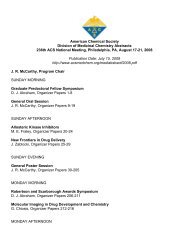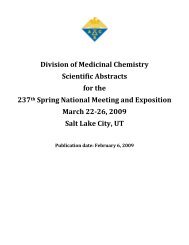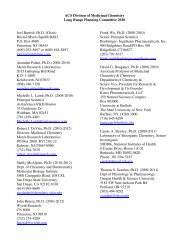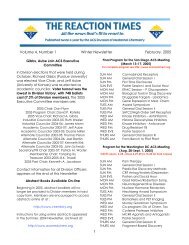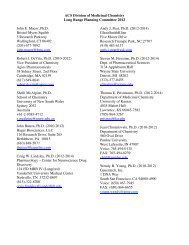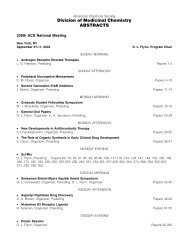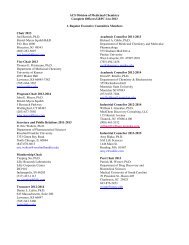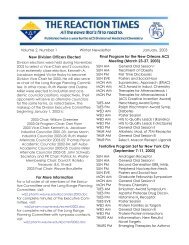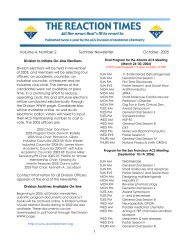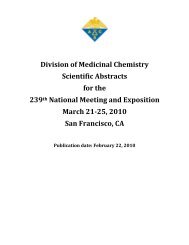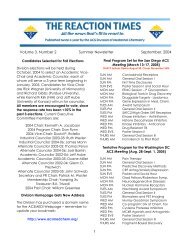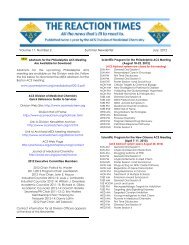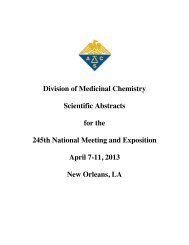Division of Medicinal Chemistry Abstracts-235th ACS National ...
Division of Medicinal Chemistry Abstracts-235th ACS National ...
Division of Medicinal Chemistry Abstracts-235th ACS National ...
- No tags were found...
Create successful ePaper yourself
Turn your PDF publications into a flip-book with our unique Google optimized e-Paper software.
MEDI 64<br />
Indole-phenylacetic acid inhibitors <strong>of</strong> CRTH2<br />
Michael G. Johnson, Jiwen Liu, An-Rong Li, Yingcai Wang, Wang Shen, Sarah Lively, Yongli<br />
Su, Bettina van Lengerich, Xuemei Wang, Sujen Lai, Matt Brown, Shauna Lawliss, Ying Sun,<br />
Qingge Xu, Tassie Collins, Jay Danao, Lisa Seitz, Mark Grillo, Jill Wait, and Julio Medina,<br />
Amgen Inc, 1120 Veterans Blvd, San Francisco, CA 94080, mgjohnso@amgen.com<br />
CRTH2 mediates inflammatory cell trafficking and has been identified as a target for the<br />
treatment <strong>of</strong> asthma. As part <strong>of</strong> our effort to develop CRTH2 antagonists we discovered a potent<br />
series <strong>of</strong> indole-phenylacetic acid derivatives that inhibit binding <strong>of</strong> 3H-PGD2 to CRTH2<br />
receptors on 293 cells and have favorable pharmacokinetic pr<strong>of</strong>iles in the rat. However, the<br />
initial representative compounds <strong>of</strong> this class displayed CYP 3A4 time-dependent inhibition.<br />
Here we describe the optimization <strong>of</strong> this series <strong>of</strong> indole derivatives that led to the discovery <strong>of</strong><br />
potent CRTH2 antagonists devoid <strong>of</strong> time-dependent 3A4 inhibition. These compounds and<br />
their analogs may be useful tools for the evaluation <strong>of</strong> CRTH2 activity in vivo.<br />
MEDI 65<br />
Synthesis and evaluation <strong>of</strong> a series <strong>of</strong> 7-substituted-8-azaquinazolinone CXCR3<br />
antagonists<br />
Darin J. Gustin 1 , Phillipe Bergeron 1 , Johann Chan 2 , Xiaoqi Chen 1 , Jeff Diegnan 1 , Du Xiaohui 1 ,<br />
Jeff MIhalic 1 , Theresa Carabeo 1 , Collins Tassie 1 , Lemon Brian 1 , George Tonn 1 , and Julio C.<br />
Medina 1 . (1) Amgen Inc, 1120 Veterans Blvd., South San Francisco, CA 94080,<br />
dgustin@amgen.com, (2) Amgen Inc, Thousand Oaks, CA 91320<br />
CXCR3 is a Gi coupled GPCR receptor that plays an important role in the recruitment <strong>of</strong> T-cells<br />
to sites <strong>of</strong> inflammation. Considerable evidence demonstrates that blocking T-cell infiltration has<br />
a benefit in the treatment <strong>of</strong> immune response mediated diseases. Thus, it is expected that the<br />
development <strong>of</strong> CXC3 antagonists may find use in the treatment <strong>of</strong> rheumatoid arthritis (RA)<br />
multiple sclerosis (MS) and cardiac transplant (allograph) rejection. We have previously<br />
described a series <strong>of</strong> 8-azaquinazolinone based CXCR3 antagonists. As part <strong>of</strong> our study <strong>of</strong><br />
these inhibitors, a series <strong>of</strong> 7-substituted-8-azaquinazolinones were prepared and evaluated for<br />
CXCR3 binding affinity and for the inhibition <strong>of</strong> CXCR3 mediated cell migration <strong>of</strong> human PBMC<br />
cell induced by ITAC. It was found that certain C(7) substituents provided significant potency<br />
improvement in CXCR3 affinity while maintaining good in vivo PK parameters.<br />
MEDI 66<br />
Imidazoacridinones: Potent inhibitors <strong>of</strong> FLT3 for the treatment <strong>of</strong> autoimmune diseases<br />
Kenneth W. Duncan, Xinqin Fang, Jennifer L. Christensen, MyDoanh Chau, Keith J. Goodman,<br />
Ann Locniskar, and Alfred M. Ajami, Xanthus Pharmaceuticals Inc, 300 Technology Square,<br />
Cambridge, MA 02139, kenneth.duncan@xanthus.com



